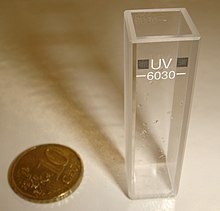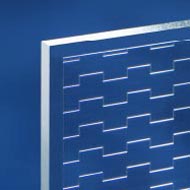Cuvette
![]()
The title of this article is ambiguous. For the meaning in dental technology, see Dental technology#Total prosthesis.
![]()
This article or subsequent section is not sufficiently supported by evidence (e.g., anecdotal evidence). Information without sufficient evidence may be removed in the near future. Please help Wikipedia by researching the information and adding good supporting evidence.
A cuvette (French cuvette 'small vessel') is a vessel with plane-parallel sides that is used for optical investigations (UV/VIS spectroscopy), for example as a resonator in dye lasers. Cuvettes are available in different qualities, depending on their intended use. They are usually made of glass or plastic. For wavelengths below 200 nm, cuvettes made of quartz glass are required. A special type of cuvette is the photocuvette used in aquaristics. The simplest cuvette imaginable consists of only 2 glass plates - without spacers -, allows layer thicknesses in the micrometer range, without dilution and is suitable for the visual comparison of strongly light-absorbing liquids such as blood, cosmetics or heavy fuel oil.

Cuvette (with 10 cent coin for size comparison).
Division
Cuvettes are classified according to:
- the glass (depending on the desired transmission and resistance)
- the layer thickness (e.g. in standard and micro cuvettes with and without spacer)
- the construction (into dismountable, compact and disposable cuvettes)
- the physical state of the sample (in liquid and gas cells)
- the sample feed (in flow-through cuvettes and cuvettes for manual sample feed)
- the measuring accuracy (in routine and precision cuvettes)

Quartz glass wafer with microchannel structure as a precursor for a batch size nanoliter cuvettes
Cell test
Cell tests are analytical methods used to measure chemical parameters of solutions photometrically. The solution is reacted with reagents specific to the parameter of interest. This reaction causes a change in the color or other optical properties of the solution. These changes can then be measured photometrically. They are directly related to the concentration of the investigated substance in the solution and therefore allow quantitative statements to be made.
So-called disposable cuvettes are often used, which already contain the necessary reagents in the correct quantity. Only a defined amount of the liquid to be tested (e.g. drinking water) is poured into the cuvette and the reaction begins after mixing. Depending on the parameter under investigation, the reaction time can range from a few minutes to several hours. Sometimes heating (e.g. in the case of COD) or the addition of further reagents is necessary during the course of the reaction. After completion of the reaction, the photometric measurement can be carried out. Commercial suppliers of cell tests offer photometer devices with microprocessors for this purpose, which immediately convert the measured absorbance into the desired concentration value and display it digitally.
Due to their speed and ease of use, cuvette tests are used in water analysis, among other applications. Examples are environmental and food processing companies, such as sewage treatment plants, waterworks, breweries or dairies. Another area is the HB rapid test for blood donations.
Search within the encyclopedia